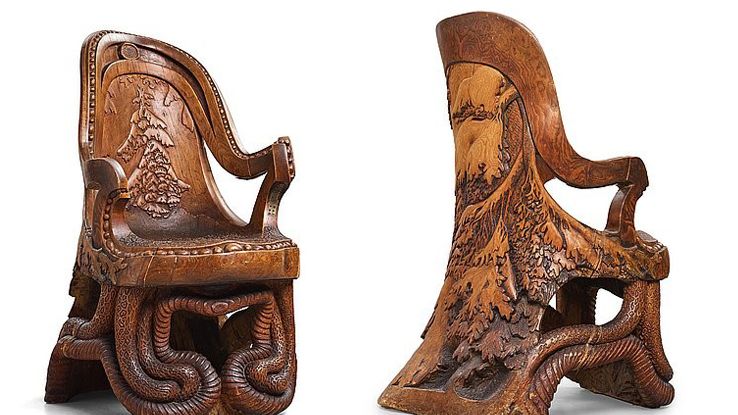
Press release -
New acquisition: The Seven Years’ Throne by Knut Fjaestad
Nationalmuseum has recently acquired a so called “stabbestol” chair with large snow-laden branches build up the back. This unique chair was designed and carved by Knut Fjaestad and took seven years to manufacture and it was completed in 1914. The length of the process earned the chair its name, The Seven Years’ Throne.
Knut Fjaestad (1860-1937) began carving wooden furniture around 1907, when he bought Bjälbo, an 18th century house located on Skärsätra gård on Lidingö island. He had previously worked as a merchant in the Old Town of Stockholm. Knut was inspired to craft the chair when he saw the stabbestol chair which his younger brother Gustaf Fjaestad (1868–1948) had made for Ernest Thiel (1859-1947). Gustaf had carved stabbestol chairs since 1894, when the earliest known examples of the style were manufactured. This type of chair was produced and got its shape from the material from which it was fashioned – namely, a log. The most famous Gustaf Fjaestad furniture group is the large sofa group that he created for Thiel, and which is now on display at the Thiel Gallery. Unlike his brother, who studied at the Royal Academy of Fine Arts and the Swedish Artists’ Association school, Knut was an autodidact (an uneducated artist).
Knut Fjaestad’s artistic activity can be said have been shaped by two trends. On the one hand, he worked in an era characterized by a passion for all things artistically unique and handmade, heavily influenced by the British Arts and Crafts movement active at the end of the 19th century. At the same time, a national variant of the Art Nouveau style was developing in Sweden. Fjaestad transformed these two movements and left his own mark on them through his handmade, carved furniture. He worked at a time when Swedish motifs were particularly central in the country’s art; Richard Bergh (1858-1919) was among the artists to emphasize them. The artists searched for the mysterious inner essence of man and nature and what they perceived as genuinely Nordic. Bergh elevated the gnarled scrub pine – stunted and gnarled as a result of having grown in a harsh, windy, and nutrient-poor environment – into the symbol of Swedish art.
Knut Fjaestad himself called his carved wooden furniture “fantasy works” and first presented them at an exhibition at Birger Jarlsgatan in Stockholm in 1923. The contemporary press discussed these pieces of furniture, noting that “they do not remind us of anything we have seen before, neither of antiquity nor of the present, Rococo nor futurism; rather, they are completely distinctive.” Each piece of furniture was uniquely designed and the material – stumps and logs of both spruce and birch – decided what kind of furniture it would become. To produce the relief work and surface texture of the furniture, Fjaestad carved, oiled, tarred, and burned the wood. The white surfaces were added by scrubbing the wood. Through this acquisition, the museum has expanded its collection of furniture from the period. Nationalmuseum already has a stabbestol chair by Gustaf Fjaestad, but this is the first work by Knut Fjaestad to be added to the collections.
Nationalmuseum receives no state funds with which to acquire design, applied art and artwork; the collections are enriched through donations and funds from private foundations and trusts. The acquisition is a gift from Ann Stern through the Friends of Nationalmuseum.
Inventory number NMK 194/2018
For more information
Anders Svensson, Assistant curator, anders.svensson@nationalmuseum.se, +46 (0)8 5195 4481
Hanna Tottmar, Head of Press, press@nationalmuseum.se, +46 (0)8 5195 4400
Categories
Nationalmuseum is Sweden’s museum of art and design. The collections comprise older paintings, sculpture, drawings and graphic art, and applied art and design up to the present day. The museum building has currently been renovated and reopened October 13, 2018. Nationalmuseum has partnerships with Svenska Dagbladet and the Grand Hôtel Stockholm.

